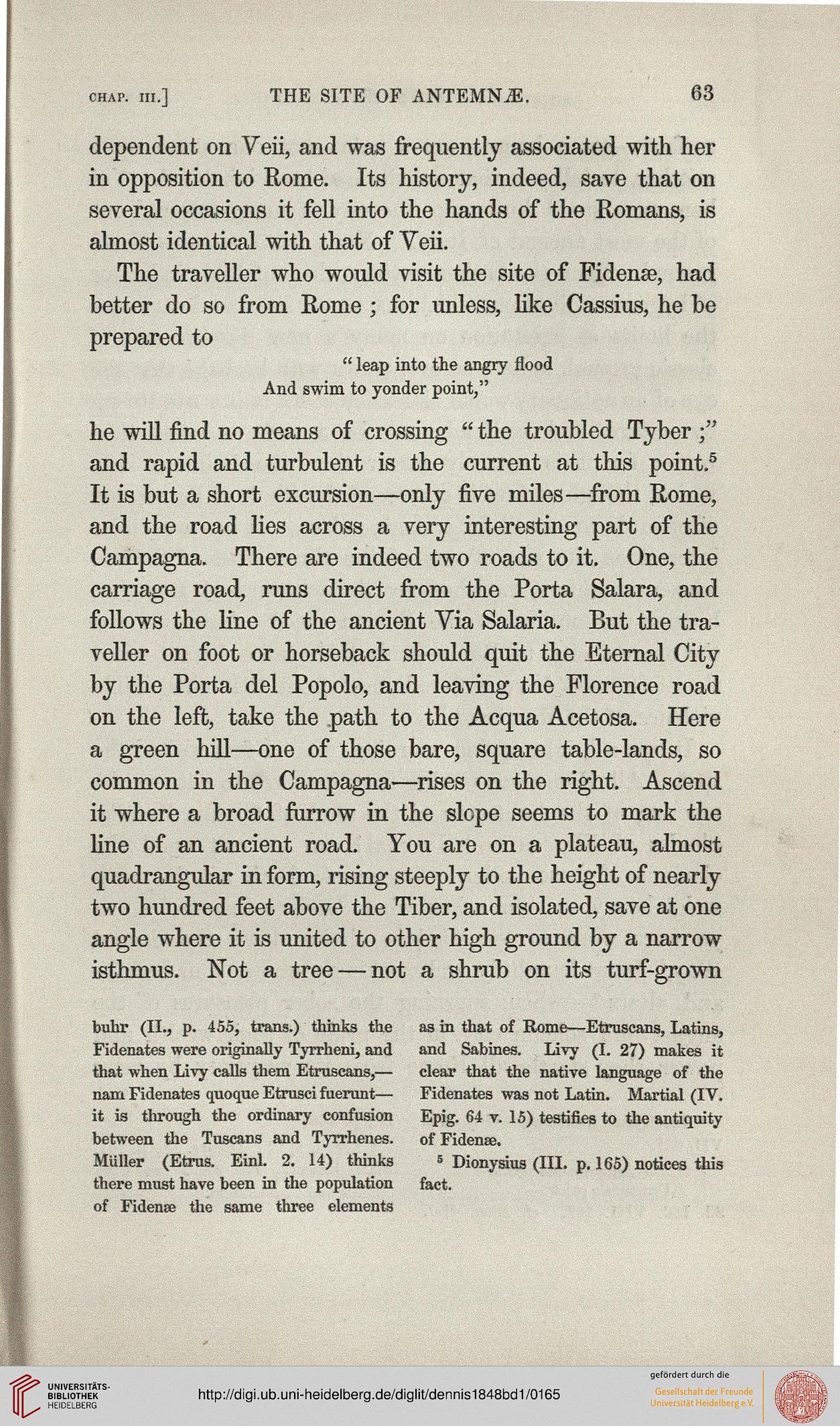chap, in.] THE SITE OF ANTEMNJE. 63
dependent on Veii, and was frequently associated with her
in opposition to Rome. Its history, indeed, save that on
several occasions it fell into the hands of the Romans, is
almost identical with that of Veii.
The traveller who would visit the site of Fidense, had
better do so from Rome ; for unless, like Cassius, he be
prepared to
" leap into the angry flood
And swim to yonder point,"
he will find no means of crossing " the troubled Tyber ;"
and rapid and turbulent is the current at this point.5
It is but a short excursion—only five miles—from Rome,
and the road lies across a very interesting part of the
Campagna. There are indeed two roads to it. One, the
carriage road, runs direct from the Porta Salara, and
follows the line of the ancient Via Salaria. But the tra-
veller on foot or horseback should quit the Eternal City
by the Porta del Popolo, and leaving the Florence road
on the left, take the path to the Acqua Acetosa. Here
a green hill—one of those bare, square table-lands, so
common in the Campagna—rises on the right. Ascend
it where a broad furrow in the slope seems to mark the
fine of an ancient road. You are on a plateau, almost
quadrangular in form, rising steeply to the height of nearly
two hundred feet above the Tiber, and isolated, save at one
angle where it is united to other high ground by a narrow
isthmus. Not a tree — not a shrub on its turf-grown
buhr (II., p. 455, trans.) thinks the as in that of Rome—Etruscans, Latins,
Fidenates were originally Tyrrheni, and and Sabines. Livy (I. 27) makes it
that when Livy calls them Etruscans,— clear that the native language of the
nam Fidenates quoque Etrusci fuerunt— Fidenates was not Latin. Martial (IV.
it is through the ordinary confusion Epig. 64 v. 15) testifies to the antiquity
between the Tuscans and Tyrrhenes. of Fidense.
MUller (Etrus. Einl. 2. 14) thinks s Dionysius (III. p. 165) notices this
there must have been in the population fact,
of Fidense the same three elements
dependent on Veii, and was frequently associated with her
in opposition to Rome. Its history, indeed, save that on
several occasions it fell into the hands of the Romans, is
almost identical with that of Veii.
The traveller who would visit the site of Fidense, had
better do so from Rome ; for unless, like Cassius, he be
prepared to
" leap into the angry flood
And swim to yonder point,"
he will find no means of crossing " the troubled Tyber ;"
and rapid and turbulent is the current at this point.5
It is but a short excursion—only five miles—from Rome,
and the road lies across a very interesting part of the
Campagna. There are indeed two roads to it. One, the
carriage road, runs direct from the Porta Salara, and
follows the line of the ancient Via Salaria. But the tra-
veller on foot or horseback should quit the Eternal City
by the Porta del Popolo, and leaving the Florence road
on the left, take the path to the Acqua Acetosa. Here
a green hill—one of those bare, square table-lands, so
common in the Campagna—rises on the right. Ascend
it where a broad furrow in the slope seems to mark the
fine of an ancient road. You are on a plateau, almost
quadrangular in form, rising steeply to the height of nearly
two hundred feet above the Tiber, and isolated, save at one
angle where it is united to other high ground by a narrow
isthmus. Not a tree — not a shrub on its turf-grown
buhr (II., p. 455, trans.) thinks the as in that of Rome—Etruscans, Latins,
Fidenates were originally Tyrrheni, and and Sabines. Livy (I. 27) makes it
that when Livy calls them Etruscans,— clear that the native language of the
nam Fidenates quoque Etrusci fuerunt— Fidenates was not Latin. Martial (IV.
it is through the ordinary confusion Epig. 64 v. 15) testifies to the antiquity
between the Tuscans and Tyrrhenes. of Fidense.
MUller (Etrus. Einl. 2. 14) thinks s Dionysius (III. p. 165) notices this
there must have been in the population fact,
of Fidense the same three elements




